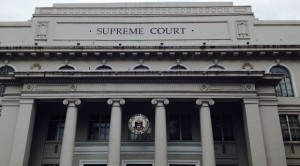MANILA, Philippines—Upholding civil liberties, the Supreme Court declared unconstitutional part of a Commission on Elections resolution setting tighter airtime limits on political ads, in a decision on Tuesday that made permanent a temporary restraining order the court issued a month before the 2013 midterm elections.
Voting 14-0, the high court partially granted petitions filed by several broadcast networks last year assailing Section 9(a) of Comelec Resolution No. 9615, a Jan. 15, 2013 measure allowing national political candidates an “aggregate total” of 120 minutes of television ads and 180 minutes of radio ads, and local political candidates 60 minutes of total TV airtime and 90 minutes of total radio airtime covering all stations.
This “aggregate total,” according to the assailed section, covered all ads “whether by purchase or donation” aired over “national, regional, local, free or cable television networks” and all “national, regional, or local radio.”
Candidates for national elective positions were originally allowed two hours of ads per TV station and three hours per radio station. Broadcast stations questioned the “restrictive” news regulations in February last year, citing how the drastic reduction in allowed airtime would deprive the public of the right to information.
In its unanimous decision, the high court said Section 9(a) of Comelec Resolution No. 9615—amended on Feb. 1, 2013 by Resolution No. 9631 to correct a typographical error— is “declared unconstitutional and therefore null and void” while the rest are “upheld and remains in full force and effect.”
The decision, the dispositive portion of which was released Tuesday, also rendered permanent the TRO the high court issued on April 16 last year that allowed the old regulations to remain in effect during the campaign period.
In ruling against the restrictive section of the Comelec resolution, the high court cited how the regulation breached basic freedoms and lacked prior consultation before its implementation.
“Among the reasons relied upon by the Court in striking down Section 9(a) were: (a) the arbitrary manner by which Comelec changed the previous regulation from “per station” to “aggregate total”, (b) the violation of freedom of expression, speech and of the press; (c) the violation of the people’s right to suffrage; (d) the absence of prior hearing before adoption,” said Supreme Court spokesperson Theodore Te in briefing notes he sent to the mass media.
The high court ruling upheld other sections of the resolution as “it did not impose an unreasonable burden on the broadcast industry and the provision of the right to reply is reasonable under the circumstances.”
The sustained parts of the resolution also include Section 9(b), which sets limits on political ad placements in the print media, and Section 9(c), which covers online election propaganda.
Comelec has endeavored to enforce stricter regulations on the airtime cap for political candidates to level the playing field as intended by the Fair Elections Act, a 2001 measure that set forth campaign regulations.
The high court has yet to release the full decision.
Petitioners against the Comelec resolution included GMA Network Inc., ABS-CBN, TV5 and the Kapisanan ng mga Brodkaster ng Pilipinas.
In their separate petitions, broadcast networks said the resolution violated the people’s right to suffrage and information, and that it provided vague mechanics on airtime aggregation, making stations vulnerable to liability.
RELATED STORIES
Comelec cuts total airtime on TV to 120 minutes
SC ruling on air time limit bad for UNA candidates
